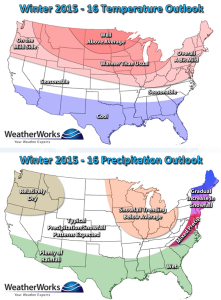 It’s that time of year again… we’re prepping our staff to create Certified Snowfall Totals and everybody is wondering what to expect for the upcoming winter. After two frigid and snowy winters across the Eastern US, will 2015-16 be another one? As of right now, it looks like the answer is no.
It’s that time of year again… we’re prepping our staff to create Certified Snowfall Totals and everybody is wondering what to expect for the upcoming winter. After two frigid and snowy winters across the Eastern US, will 2015-16 be another one? As of right now, it looks like the answer is no.
If you have been following weather over the last couple of months, then it shouldn’t be too surprising to hear that the strong El Niño is expected to be a major player in determining our weather during the colder months. As a quick reminder, El Niño, or the “warm” phase of the El Niño Southern Oscillation (ENSO), and refers to the anomalous warming of the central and eastern Tropical Pacific Ocean. Not only is the current event considered a “strong” El Niño, but it is also on pace to rival the strongest events ever.
The pattern during strong El Niños is typically characterized by a large trough of low pressure over the Gulf of Alaska, with a ridge of high pressure extending over much of the Northern US. This is the complete opposite of the set-up we had in 2013-14 and 2014-15, which featured ridging along the West Coast and a broad trough over the Eastern US. So, what exactly does this mean for the East Coast and Midwest? Strong El Niños correlate with milder than average winters across the northern part of the country. In addition, the Midwest and Ohio Valley generally end up with below average snow totals. As for the East Coast, the relationship between snowfall and strong El Niño is weaker (though they average out below normal as well).

So with a strong El Niño in control, an overall milder winter is forecast for the Midwest, Northeast and Mid-Atlantic. This will be especially true during the first half of winter, as things will likely get off to a relatively slow start. In addition, the lack of sustained cold air will favor more mixed precipitation events than in prior years. However, we do expect things to pick up by the time we move into February. And with an active southern branch of the jet stream, folks along the Eastern Seaboard will have to keep an eye out for a few “big snow” threats. Despite a forecast of slightly below average snowfall on the East Coast, don’t forget that it only takes one big storm to deliver significant snowfall across the Northeast and Mid-Atlantic.